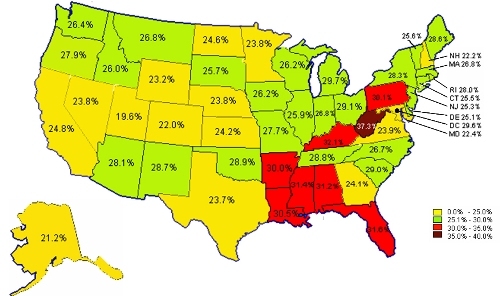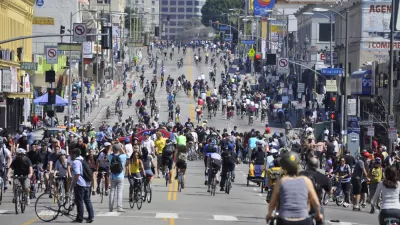I find it intriguing when I hear folks talk about how high energy prices will cause a tipping point and everyone will rush back into the city in order to afford to commute to work. If, or as, higher costs for energy begin to play a greater role in location choice it is as likely that they will force even more employers to move to the suburbs. In many urban areas we may be well past the point where fuel price pressures to minimize travel would result in land use changes that move population back to town.
I find it intriguing when I hear folks talk about how high energy prices will cause a tipping point and everyone will rush back into the city in order to afford to commute to work. If, or as, higher costs for energy begin to play a greater role in location choice it is as likely that they will force even more employers to move to the suburbs. In many urban areas we may be well past the point where fuel price pressures to minimize travel would result in land use changes that move population back to town.
Perhaps even more intriguing is the number of planners that feel residential clustering around employment is the be all and end all of urban planning to minimize travel (no doubt the majority of readers of this august sophisticated Planetizen resource are far more nuanced in their thinking). Interestingly, two of the hottest trends in travel behavior are the growth in the work-at-home segment of the workforce and the share of households with no workers. The American Community Survey indicted that 3.6 percent of workers work at home. This share exceeds the bike and walk shares and is rapidly gaining ground on transit users. This is a share that could explode with meaningfully higher energy costs or constraints on fuel availability. Aging population, corporate restructuring, privatization, and ever improving/low cost communications and computerization are among the trends that support this phenomenon.
Perhaps less attention grabbing is the magnitude of the share of households that do not have any workers. While demographers and other are speculating on how the baby boomers will behave in old age, specifically, if or when they will quit working, there is every reason to believe that the share of households with no workers will increase with the aging of the country. Only massive immigration or a stunning reversal of fertility trends could create a population profile that is likely to have higher labor force participation in the next few decades. The figure below shows shares of households with no workers by state. Nationally 27 percent of households have no workers, 31.6 percent in Florida and as high as 38 percent in West Virginia. That is a whole lot of folks whose travel decisions and housing location decisions are not driven by a need to commute to downtown or any other jobs.
So the answer is simple, as energy costs get higher we move all those folks that don't work and place them in the distant suburbs, put the folks that work at home next to them and then optimize the home and workplace locations for the remainder. The policy wonks can conjure up a set of regulations and incentives to help fix this nasty problem of higher energy costs and of course all that real estate activity will get the housing market going again.
Share of Households with Zero Workers, 2005 ACS

If fuel prices do continue to outpace inflation and incomes they may begin to have a more meaningful affect on travel behaviors. The nature and magnitude of that response will no doubt suprise many. The costs of higher fuel prices are impacting individuals and small businesses but it is important to keep in mind that the several hundred dollar per year increase in fuel cost for an average vehicle is well less than the cost of a sunroof, those fancy new oversized tires and rims folks seem to be buying in droves, and only a fraction of the cost of those new navigation systems increasingly common in vehicles. Wake me up when gas passes $6 per gallon then we can talk about the impacts on travel and location decisions. In the meantime keep in mind access to work is important but only one of many travel destinations and a declining share of all travel.

Planetizen Federal Action Tracker
A weekly monitor of how Trump’s orders and actions are impacting planners and planning in America.

Restaurant Patios Were a Pandemic Win — Why Were They so Hard to Keep?
Social distancing requirements and changes in travel patterns prompted cities to pilot new uses for street and sidewalk space. Then it got complicated.

Map: Where Senate Republicans Want to Sell Your Public Lands
For public land advocates, the Senate Republicans’ proposal to sell millions of acres of public land in the West is “the biggest fight of their careers.”

Maui's Vacation Rental Debate Turns Ugly
Verbal attacks, misinformation campaigns and fistfights plague a high-stakes debate to convert thousands of vacation rentals into long-term housing.

San Francisco Suspends Traffic Calming Amidst Record Deaths
Citing “a challenging fiscal landscape,” the city will cease the program on the heels of 42 traffic deaths, including 24 pedestrians.

California Homeless Arrests, Citations Spike After Ruling
An investigation reveals that anti-homeless actions increased up to 500% after Grants Pass v. Johnson — even in cities claiming no policy change.
Urban Design for Planners 1: Software Tools
This six-course series explores essential urban design concepts using open source software and equips planners with the tools they need to participate fully in the urban design process.
Planning for Universal Design
Learn the tools for implementing Universal Design in planning regulations.
Heyer Gruel & Associates PA
JM Goldson LLC
Custer County Colorado
City of Camden Redevelopment Agency
City of Astoria
Transportation Research & Education Center (TREC) at Portland State University
Camden Redevelopment Agency
City of Claremont
Municipality of Princeton (NJ)





























